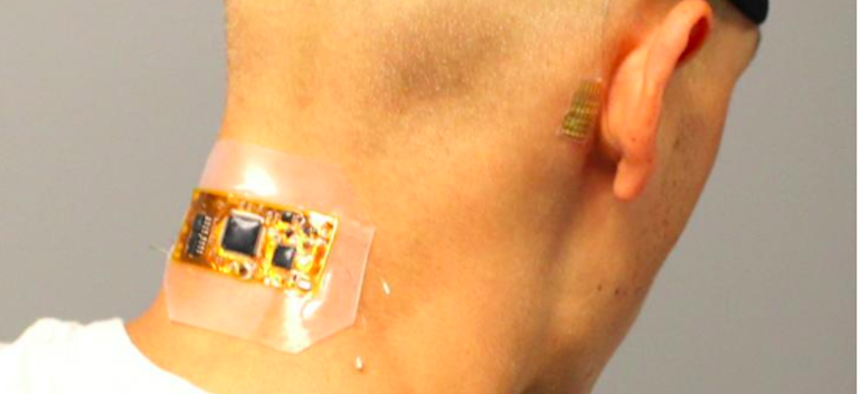
Test subject who has flexible wireless electronics conformed to the back of the neck, with dry hair electrodes under a fabric headband and a membrane electrode on the mastoid, connected with thin-film cables. Courtesy Woon-Hong Yeo
A New Joystick For the Brain-Controlled Vehicles Of the Future
An innovative sensor strip promises a far better way to connect human brains to machines.
The U.S. military has a growing interest in brain-computer interfaces: sensors that pick up brain signals and electronics that convert them to digital information that can be read by computers. But today’s most common way to pick up the brain's electromagnetic signals via electroencephalography, or EEG, involves sensor-studded caps that are bulky, look ridiculous, need to be connected via wires to other machines, and often require conductive jelly in order to work. Moreover, they work unpredictably depending on individual factors like hair. They’re poorly suited for regular life, much less for soldiers.
A group of scientists from several universities has created an unobtrusive brain-computer interface strip that could revolutionize the way humans convert their thoughts into a machine-readable format.
A narrow strip affixes to the upper neck, performing the data collection of a traditional EEG cap. The signals are then interpreted by software —aided by machine learning— to produce data that could be used to steer vehicles or operate other computers. The entire system is called SKINTRONICS.
“We demonstrated that this portable, flexible wearable system can control an electric wheelchair, mini-car, and a software-presentation” Woon-Hong Yeo, a researcher of the Georgia Institute of Technology, told Defense One over email. Yeo and his colleagues’ paper appears in the current issue of the journal Nature Machine Intelligence.
Yeo and his team designed the strip for people who have lost mobility, but its advantages over the EEG cap promise to give it much wider applicability.
“Yes, obviously this system can be used for controlling other devices including military equipment,” he said.
The U.S. military in recent years has invested heavily in research in different types of brain and computer interfaces. In 2015, the Defense Advanced Research Projects Agency, or DARPA, revealed that a woman with a surgically implanted chip had piloted a virtual F-35. Last September, they showed that a person outfitted with the same chip could steer a virtual assortment of drones.
The Chinese military is also moving ahead with similar research, according to Elsa Kania, a fellow with the Technology and National Security Program at the Center for a New American Security.
Beyond brain-based piloting, the military is exploring the use of brain-computer interfaces for communication. In 2008, the U.S. Army gave $4 million to researchers at the University of California, Irvine to study what the researchers described as “synthetic telepathy.” A person wearing an EEG cap or in a magnetoencephalographic chamber would attempt to trick their brain into sending out electronic signals in a form that could be read as communication — in fact, Morse code.
Wrote Yeo, “Currently, we have limitations of differentiating brain signals (less than 10 different types) to control external hardware or software, which will be resolved by enhancing the machine learning algorithm and optimizing the circuit design, while increasing the brain signal amplitude via a better skin contact of electrodes.”
All of these efforts, plus emerging work to treat PTSD via specialized brain-based therapies, could benefit from an interface that, according to the paper, outperforms traditional EEG caps and is less intrusive.







